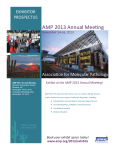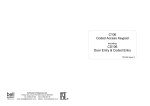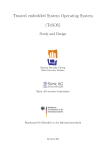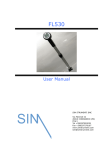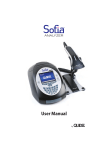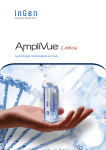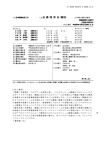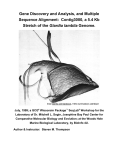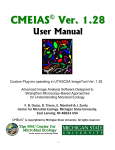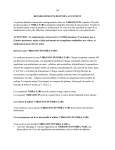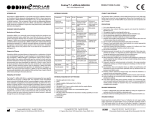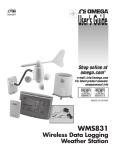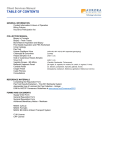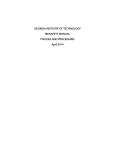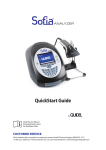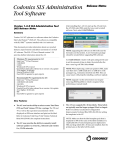Download GBS Assay
Transcript
GBS Assay For the qualitative detection of Group B Streptococcus from vaginal/rectal swabs following 18 to 24 hours incubation in Lim broth. Developed with Biohelix® technology AmpliVue GBS Assay Page 1 of 14 Contents Intended Use ................................................................................................................................... 3 Summary and Explanation .............................................................................................................. 3 Principle of the Procedure .............................................................................................................. 3 Materials Provided .......................................................................................................................... 4 Materials Required But Not Provided............................................................................................. 4 Warnings and Precautions .............................................................................................................. 4 Storage and Handling of Kit Reagents ............................................................................................ 5 Specimen Collection, Storage and Handling ................................................................................... 5 Assay Procedure.............................................................................................................................. 5 Heat Lysis ............................................................................................................................ 5 Amplification ....................................................................................................................... 6 Detection............................................................................................................................. 6 Warning............................................................................................................................... 6 Interpretation of Results ................................................................................................................. 7 Quality Control ................................................................................................................................ 7 Limitations....................................................................................................................................... 8 Expected Values .............................................................................................................................. 8 Clinical Performance ....................................................................................................................... 8 Analytical Performance ................................................................................................................... 9 Limit of Detection ............................................................................................................... 9 Analytical Reactivity (Inclusivity) ........................................................................................ 9 Repeatability Study ............................................................................................................. 9 Reproducibility Study .......................................................................................................... 9 Analytical Specificity – Cross-reactivity and Microbial Interference ................................ 10 Analytical Specificity – Interfering Substances ................................................................. 11 Carryover – Cross Contamination ..................................................................................... 12 Customer and Technical Assistance.............................................................................................. 12 Intellectual Property ..................................................................................................................... 12 Trademarks ....................................................................................................................... 12 Patents .............................................................................................................................. 12 Glossary ......................................................................................................................................... 13 AmpliVue GBS Assay Page 2 of 14 Intended Use The AmpliVue® GBS Assay is a qualitative in vitro diagnostic test for the rapid detection of Group B Streptococcus from vaginal/rectal swabs from antepartum women following 18 to 24 hours of incubation in an LIM enrichment broth culture. The AmpliVue® GBS Assay utilizes helicase-dependent amplification (HDA) of the thiolase (atoB) gene sequence and a self-contained disposable amplification detection device that allows for manual evaluation of assay results. The AmpliVue® GBS Assay does not provide susceptibility results. Culture isolates are needed for performing susceptibility testing as recommended for penicillin-allergic women. The AmpliVue® GBS Assay is intended for use in hospital, reference or state laboratory settings. The device is not intended for point-of-care use. Summary and Explanation The AmpliVue® GBS Assay combines simple sample processing, an isothermal amplification technology named helicase-dependent amplification (HDA), and a self-contained disposable amplicon detection device, for the detection of Group B Streptococcus from vaginal / rectal swabs following 18 to 24 hours incubation in Lim enrichment broth culture. A small amount of cultured specimen is transferred into a dilution tube. The diluted sample culture is then transferred into a lysis tube, and the cells are lysed by simple heat treatment. After heat treatment, an aliquot of the lysed sample is added to a reaction tube containing lyophilized mix of HDA reagents including primers specific for the amplification of the thiolase (atoB) gene. The rationale behind the selection of this particular target sequence were: 1) a BLAST search of this gene resulted in no thiolase with significant homology in species other than those belonging to S. agalactiae; 2) the gene is conserved in GBS based on the recent GBS Genome project. The assay also includes a process control that monitors sample processing, confirms the integrity of the assay reagents and cassette detection, and assays for HDA-inhibitors that may be present within a broth culture. After completion of the HDA reaction, the reaction tube is transferred to a cassette for rapid detection with test result displayed as test and/or control lines in the window of the cassette. Streptococcus agalactiae (Group B Streptococcus or GBS) is a Gram positive coccus bacterium that is found in a number of sources in healthy adults (gastrointestinal, genital and urinary tract). It is estimated that any given time 20% of pregnant women are colonized with GBS. It is associated with asymptomatic bactiuria, urinary tract infection, and amnionitis, and in women who have recently delivered, it causes endometritis and wound infection.1 In the 1970’s, GBS was a leading infectious cause of early neonatal morbidity and mortality.2 As a result of prevention efforts, incidence of GBS has declined dramatically, from 1.7 cases per 1,000 live births in the early 1990s to 0.34 to 0.37 cases per 1,000 live births in 2008. The CDC estimates that GBS has caused approximately 1,200 cases of early-onset invasive disease per year.3 The most common clinical syndromes of early-onset disease are sepsis and pneumonia; less frequently, early onset infections can lead to meningitis. Mortality of babies born at term (> 37 weeks’ gestation) is 2 to 3%, but among preterm infants the mortality can be as high as 30%. Screening for GBS colonization in antepartum women (between 35 and 37 weeks’ gestation), is one of the key components of the CDC’s GBS screening strategy and is an effective mechanism for prevention of perinatal Group B Streptococcal disease. As colonization may be transient, intermittent or persistent throughout pregnancy, screening is most effective when performed when specimens are collected no more than five weeks (35 to 37 weeks gestation) prior to delivery and after enrichment with selective broth medium. Principle of the Procedure Following specimen lysis, amplification of the atoB gene occurs if GBS is present in the HDA reaction. Competitive amplification of the process control DNA also takes place unless amplification inhibitory substances are present or the sample processing fails. The HDA reaction is asymmetric so that an excess of single stranded DNA is formed from a biotinylated primer present within the reaction mix. AmpliVue GBS Assay Page 3 of 14 The capture probes for each amplicon bind to the corresponding biotinylated single-stranded DNA and this duallabeled probe-amplicon hybrid are then detected by using a proprietary detection cassette. The bottom line captures the FITC-labeled probe-target amplicon and the top line captures the DNP-labeled probe-control amplicon. The biotin label attracts the streptavidin-conjugated color particles for visualization and the test result is shown as colored lines visible to the naked eye. The self-contained cassette is comprised of two individual components: an amplicon cartridge that holds the running buffer and a single 0.2-mL thin wall reaction tube containing the amplified product; and the detection chamber which houses the amplicon cartridge and a verticalflow DNA detection strip embedded into the cassette. The DNA detection strip is coated with an anti-FITC antibody and an anti-DNP antibody that serve as the GBS test (T) line and the control (C) line respectively in the assay. A razor blade and a plastic pin located at the bottom of the detection chamber open the HDA reaction tube and the running buffer bulb when the handle of the detection chamber is closed. The mixture flows through a fiberglass paper connected to the DNA detection strip that is attached with a fiberglass pad pre-loaded with streptavidinconjugated color particles for color visualization. Detection of GBS is reported when the T line is visible through the detection window of the cassette. No detection of GBS is reported when only the C line is displayed. The assay is regarded as unresolved when neither line is displayed. Materials Provided SKU # M202 16 Tests per Kit Symbol Component Detection Cassettes Part 1185001 Quantity 16/kit Storage 2° to 30°C Dilution Buffer Part M5064 16 tubes/kit 0.35 mL 2° to 8°C Lysis Buffer Part M5066 16 tubes/kit 0.35 mL 2° to 8°C Reaction Tubes Part M5077 16 tubes/kit 2° to 8°C Amplicon Cartridge Part 1215400 16/kit 2° to 30°C Materials Required But Not Provided External controls for Group B Streptococcus (e.g. Quidel Molecular GBS Control Set, which contains positive and negative controls, serves as an external processing and extraction control) Sterile DNAse-free filter-blocked or positive displacement micropipettor tips Micropipettor Stopwatch or timer Scissors or a blade Micro tube tray Heat block capable of 95 2°C temperature Heat block with heated lid capable of 64 ± 2°C temperature Thermometer Warnings and Precautions All reagents are for in vitro diagnostic use only. Treat all specimen/samples as potentially infectious. Follow universal precautions when handling samples, this kit and its contents. All tubes should be capped tightly prior to vortexing. Proper sample collection, storage and transport are essential for correct results. Store assay reagents as indicated on their individual labels. Reagents are not interchangeable between lots. Never pool reagents from different tubes even if they are from the same lot. Do not use the reagents after their expiration date. AmpliVue GBS Assay Page 4 of 14 Do not interchange caps among reagents as contamination may occur and compromise test results. Only open the tubes when adding aliquots into tubes or removing aliquots from tubes. Keep the tubes closed at any other time to avoid contamination. To avoid contamination of the environment with GBS amplicons, do not open the reaction tubes postamplification. Avoid microbial and deoxyribonuclease (DNAse) contamination of reagents when removing aliquots from tubes. The use of sterile DNAse-free disposable filter-blocked or positive displacement pipettor tips is recommended. Use a new pipettor tip for each specimen or reagents. Performing the assay outside of the recommended time ranges can produce invalid results. Assays not completed within specified time ranges should be repeated. To avoid exposure to excessive heat, care should be taken when inserting and removing tubes from the heat blocks, and when handling the heated tubes. Additional controls may be tested according to guidelines or requirements of local, state, provincial and/or federal regulations or accrediting organizations. In cases where open-tube PCR tests are conducted in the same general area by the laboratory, separated or segregated working areas should be used for specimen preparation and amplification/detection activities. Supplies and equipment should be dedicated to each area and should not be moved from one area to another. Gloves must always be worn and must be changed before going from one area to another. Gloves must be changed before manipulating the reagents. Wash hands thoroughly after performing the test. Do not pipette by mouth. Do not smoke, drink or eat in areas where specimens or kit reagents are being handled. Dispose of unused reagents and waste in accordance with county, federal, provincial, state and local regulations. Wear suitable protective clothing, gloves, eye and face protection when using this kit. For accurate results, pipette carefully using only calibrated equipment. Thoroughly clean and disinfect all surfaces with a 10% bleach solution followed by molecular grade water. Use micropipettes with an aerosol barrier or positive displacement tips for all procedures. MSDS is available upon request or can be accessed on the product website. Storage and Handling of Kit Reagents Store assay reagents and detection cassettes as indicated on their individual labels. Specimen Collection, Storage and Handling Specimens are vaginal/rectal swabs collected from antepartum women for Lim enrichment broth culture. Collection, storage, and handling of the specimens should use the CDC recommended clinical procedure.2 Sample Type: vaginal / rectal swabs following 18 to 24 hours incubation at 35 ± 2°C in Lim enrichment broth culture. The cultured enrichment broth can be stored at either 20 - 25°C or 2 - 8°C for up to 25 hours prior to testing. Assay Procedure Heat Lysis 1. 25 minutes prior to the heat lysis step warm the heating block to 95 ± 2°C. 2. Vortex the 18 to 24 hour broth culture for 15 seconds to ensure complete mixing. 3. Transfer 50 μL of the mixed broth culture to a labeled dilution tube and vortex for 10 seconds. 4. Transfer 50 μL from the dilution tube diluted broth culture to a labeled Lysis Buffer tube and vortex for 10 seconds. 5. Heat the Lysis Buffer tube at 95 ± 2°C for 10 minutes and then vortex for 10 seconds. Note: Begin 10 minute lysis procedure after placing tubes in block and waiting until block returns to 95°C. AmpliVue GBS Assay Page 5 of 14 Amplification 1. 15 minutes prior to the amplification step, warm a heating block with a heated lid to 64 ± 2°C. 2. Transfer 50 µL of lysed sample to a labeled Reaction Tube and rehydrate lyophilized reagents by pipetting up and down 3 to 5 times to mix. Close the lid tightly and proceed to the next step. 3. Incubate the Reaction Tube at 64 ± 2°C for 60 minutes in a heating block with a heated lid. Note: To avoid laboratory contamination, once the tube has been closed, and the amplification reaction started, DO NOT open the Reaction Tube. Detection 1. Tear open a new Detection Cassette package. Label the cassette appropriately. Make sure a buffer bulb is attached in the Amplicon Cartridge. 2. Place the Reaction Tube into the Amplicon Cartridge (Fig. 1, step 1). Be sure to place the HINGE of the Reaction Tube cap into the largest slot adjacent to the buffer bulb. 3. Close the Amplicon Cartridge (Fig. 1, step 2) ensuring that it snaps shut. If the cartridge does not snap shut, reposition the tube within the cartridge. 4. Insert the closed Amplicon Cartridge into the Detection Cassette (Fig. 1, step 3). Make sure the arrow faces the detection strip (Reaction Tube should face the razor blade and the plastic bulb containing the running buffer should face the pin). Identify the cassette on the top and/or side of the outer casing. 5. Keep the device upright and press the handle of the outer casing to close the device (Fig. 1, step 4). The handle will lock into place when closed completely (Fig. 1, step 5). Figure 1 6. 7. Results are read at 10 minutes. Note: the results are stable for up to sixty minutes. Discard the used Detection Chambers in sealed bags and as appropriate for your laboratory. Warning 1. DO NOT open the AmpliVue® Detection Cassette after use. Opening the cassette after use may result in amplicon contamination of the test area. 2. Remove the required number of reaction tubes from the protective pouch, remove the excess air and reseal the bag. AmpliVue GBS Assay Page 6 of 14 Interpretation of Results Any pink to red colored visible line should be recorded as positive (+) and no line should be recorded as (-); for example, “T+” = Visible T line and “T-" = No T line (See diagram below). The T2 line detects GBS DNA. The C line detects the process control DNA in the absence of the target GBS DNA. In the presence of the target GBS DNA, the C line detects amplified products from both the GBS and the process control DNA. The control line intensity may vary with each test. Any pink to red colored visible line in the control signifies a valid test. C line *T1 line T2 line Positive for GBS Negative for GBS Invalid The interpretation of the assay results is done according to the following criteria: Test line (T)Reading Control line (C) Reading Interpretation of result T2+ C+ GBS DNA detected (Positive) T2+ C- GBS DNA detected (Positive) T2- C+ No GBS DNA detected (Negative) Invalid: failure due to inhibitory specimen, reagent failure, or device failure. Repeat test with original LIM broth. *Note 1: The T1 line is not used on this assay. The presence of a T1 line should be considered invalid for this assay. Repeat test with original LIM broth. T2- C- Quality Control The AmpliVue® GBS Assay incorporates several controls to monitor assay performance. 1. 2. 3. The process control is used to monitor sample processing, to detect HDA inhibitory specimens and to confirm the integrity of assay reagents and cassette detection. The process control is included in the Dilution Buffer tube. The external positive control may be treated as a patient specimen. The control should be sampled and tested as if it were a broth culture and processed as described above in the Assay Procedure. The external positive control is intended to monitor substantial reagent and cassette failure. The external negative control may be treated as a patient specimen. The control should be sampled and tested as if it were a broth culture and processed as described above in the Assay Procedure. The external negative control is used to detect reagent or environmental contamination (or carry-over) by GBS DNA or amplicon. It is recommended that the reactivity of each new lot and each new shipment of the AmpliVue® GBS assay be verified on receipt and before use. External control tests should be performed thereafter in accordance with appropriate federal, state and local guidelines. The AmpliVue® GBS assay should not be used in patient testing if the external controls do not produce the correct results. AmpliVue GBS Assay Page 7 of 14 Limitations The main laboratory technique required is pipetting. Good laboratory technique is essential for the proper performance of this assay. Due to the high analytical sensitivity of this test, extreme care should be taken to preserve the purity of all reagents, especially in cases where multiple aliquots are taken from a tube. The AmpliVue® GBS Assay does not distinguish between viable and non-viable organisms. The AmpliVue® GBS assay is for use with vaginal/rectal swab specimens collected in accordance with established guidelines for collection of Group B Streptococcus culture specimens. Cervical, perianal, perirectal or perineal specimens are not acceptable sample types. A speculum should not be used for sample collection. Performance of the AmpliVue® GBS assay was validated with Lim broth medium only. Performance has not been validated with other GBS selective broth enrichment media. The AmpliVue® GBS assay does not provide susceptibility results. Culture isolates are needed for performing susceptibility testing as recommended for penicillin-allergic women. GBS colonization during pregnancy can be intermittent, persistent or transient. The clinical utility of GBS screening decreases when testing is performed more than five weeks prior to delivery. Evaluation of non-hemolytic colonies was not performed as part of Clinical Site testing. A negative result does not rule out the possibility of GBS colonization. False negative results may occur when the GBS concentration in the specimen is below the LoD. The AmpliVue® GBS assay is not intended to differentiate carriers of GBS from those with streptococcal disease. Mutations or polymorphisms in primer or probe binding regions may affect detection of new or unknown variants and may result in a false negative result. Expected Values Clinical performance of the AmpliVue® GBS assay with Lim enrichment broth was established in specimens from antepartum women at four clinical sites during a clinical study performed in 2013. Nine hundred and eight specimens collected from antepartum women between 35 to 37 weeks’ gestation at four distinct geographical sites across the United States, were tested. The age range for these women was between 15 to 44 years old. The percentage of positive cases as determined by the AmpliVue ® GBS assay during the study was 27.3% (248 of 908). Clinical Performance Performance characteristics of the AmpliVue® GBS Assay were established during a prospective study conducted July to November 2013. Nine hundred eleven (911) specimens used for this study were collected from antepartum women between 35 to 37 weeks’ gestation at four distinct geographical sites across the United States. The age range for these women was between 15 to 44 years old. Nine hundred eleven (911) specimens were tested by both the AmpliVue® GBS Assay and bacterial culture. Three (3) specimens (0.3%) were invalid in the AmpliVue® GBS Assay when initially tested. Three (3) specimens remained invalid upon repeat testing. We elected to calculate clinical performance based on the initial test result obtained for each specimen. Therefore, the data below is for the remaining nine hundred eight (908) specimens. Combined Sites Bacterial Culture AmpliVue® GBS Assay 95% CI POS NEG Total Sensitivity 99.5% 96.9% 100% POS 196 52* 248 Specificity 92.7% 90.5% 94.3% NEG 1** 659 660 Total 197 711 908 * Fifty-two (52) discordant specimens (AmpliVue Positive/Bacterial Culture Negative) reported above were tested with and FDA-cleared molecular device for the detection of GBS, thirty-nine (39) of these specimens were positive for GBS, and thirteen (13) were negative. ** The one (1) discordant specimen (AmpliVue Negative/Bacterial Culture Positive) reported above were tested with and FDA-cleared molecular device for the detection of GBS, and was negative. AmpliVue GBS Assay Page 8 of 14 Analytical Performance Limit of Detection The analytical sensitivity (limit of detection or LoD) of the AmpliVue® GBS Assay was determined using quantified (CFU/mL) cultures of six Streptococcus agalactiae strains serially diluted in a Lim enrichment broth. Analytical sensitivity (LoD) is defined as the lowest concentration at which 95% of all replicates tested positive. The LoD for the 6 strains tested ranged from 1.24 x 105 to 1.39 x 106 CFU/mL. Based on this data the reported LoD for the AmpliVue® GBS Assay is the highest value of the six strains: 1.39 x 106 CFU/mL. Strain Serotype CFU/Assay CFU/mL BAA-611 V 1084 1.39 x 106 SS617 Ia 543 6.96 x 105 SS618 Ib 470 6.02 x 105 SS619 II 441 5.64 x 105 ATCC 12403 III 690 8.84 x 105 SS700 Ic 97 1.24 x 105 Analytical Reactivity (Inclusivity) The reactivity of the AmpliVue® GBS Assay was evaluated against an additional twelve strains of Streptococcus agalactiae. The testing was performed near the level of detection for the assay (1x LoD). All twelve strains were detected by the AmpliVue® GBS Assay in this study at a LoD of 1084 CFU/assay (1.39 x 106 CFU/mL). Bacterial Strain ATCC 12973 CCUG 28551 CCUG 29785 ATCC 49449 ATCC 27956 ATCC 7077 ATCC 4768 ATCC 12927 ATCC 9925 ATCC 55194 ATCC 55191 CNCTC 6609 Serotype II IV VI X not typed not typed not typed not typed not typed not typed not typed VII Vendor ATCC CCUG CCUG ATCC ATCC ATCC ATCC ATCC ATCC ATCC ATCC CNCTC Repeatability Study The Precision/Within Laboratory Repeatability was determined via a study, consisting of a four-member panel (3x, 1x, 0.3x LoD and a negative sample) was tested by two (2) operators, twice a day (2X) for twelve (12) days. The AmpliVue® GBS assay produces results that are highly reproducible. This observation is based on the following findings: • All negative samples generated negative results for GBS. • The percentage of positive High Negative (0.3x LoD) samples is 47.9%, this is within the target range of 20 to 80%. • The percentage of positive of the Low Positive (1x LoD) samples was 99%. • The percentage of positive of the Moderate Positive (3x LoD) samples was 100%. Reproducibility Study In order to confirm the reproducibility of the AmpliVue® GBS Assay a blinded and randomized study panel containing Streptococcus agalactiae negative and positive samples were tested at three (3) test sites (one inhouse laboratory and two (2) clinical sites). Each site tested a reproducibility panel and Assay Controls for five AmpliVue GBS Assay Page 9 of 14 (5) days in triplicate. Testing was done by two operators at each site. Each operator ran the panel once a day using one lot of AmpliVue® GBS Assay. A total of 540 specimens were tested (including controls). The AmpliVue® GBS Assay generated reproducible results in this study. SITE Site #1 Site #2 Site #3 Category #expected #expected % % results/# results/# Agreement Agreement tested tested #expected results/# tested % Agreement Overall Percent Agreement 95% Confidence Interval GBS High Negative 18/30 60% 24/30 80% 28/30 93% 70/90 78% 68% - 85% GBS Low Positive 30/30 100% 30/30 100% 30/30 100% 90/90 100% 95% - 100% GBS Moderate Positive 30/30 100% 30/30 100% 30/30 100% 90/90 100% 95% - 100% GBS Negative 30/30 100% 30/30 100% 30/30 100% 90/90 100% 95% - 100% GBS Positive Control 30/30 100% 30/30 100% 30/30 100% 90/90 100% 95% - 100% GBS Negative Control 30/30 100% 30/30 100% 30/30 100% 90/90 100% 95% - 100% Analytical Specificity – Cross-reactivity and Microbial Interference A study was performed to determine if ninety-one microorganisms or viruses (seventy-six (76) bacteria, three yeast (3), eleven (11) viruses and a parasite (1)) potentially found in vaginal/rectal samples cross-react with the AmpliVue® GBS Assay. The same ninety-one microorganisms were used to determine if they interfered with two (2) strains of Streptococcus agalactiae at 2x LoD in the AmpliVue® GBS Assay The microorganisms were tested above clinically relevant levels (bacteria ≥ 1 x 106 CFU/mL, viruses the ≥ 1 x 105TCID50/mL). Human genomic DNA was also evaluated for cross-reactivity and interference. Bacteria Abiotrophia defective Enterococcus faecalis Acinetobacter baumanii Aeromonas hydrophila Alcaligenes faecalis faecalis Bacillus cereus Bacillus subtilis Bacteroides fragilis Bifidobacterium adolescentis Campylobacter fetus Campylobacter hyointestinalis Campylobacter jejuni Chlamydia trachomatis Citrobacter freundii Clostridium bifermentans Clostridium butyricum Clostridium difficile Clostridium haemolyticum Clostridium novyi Clostridium orbiscindens Clostridium perfringens Clostridium septicum Clostridium sordellii Clostridium sporogenes Enterococcus faecium Escherischia coli Escherischia fergusonii Gardnerella vaginalis Helicobacter pylori Klebsiella oxytoca Klebsiella pneumoniae Lactobacillus acidophilus Legionella pneumophila Listeria monocytogenes Mobiluncus mulieris Moraxella cartarrhalis Morganella morganii Neisseria gonorrhoeae Peptostreptococcus anaerobius Pleisiomonas shigelloides Porphyromonas asaccharolytica Prevotella melaninogenica Proteus mirabilus Providencia alcalifaciens Pseudomonas aeruginosa Pseudomonas fluorescens AmpliVue GBS Assay Salmonella enterica enterica Serovar Typhimurium Salmonella enterica indica Serratia liquefaciens Serratia marcescens Shigella boydii Shigella flexneri Shigella sonnei Staphyloccocus aureus Staphylococcus epidermidis Stenotrophomonas maltophila Streptoccocus mutans Streptoccocus pyogenes Streptococcus bovis Streptococcus dysgalactiae Streptococcus gordonii Streptococcus intermedius Streptococcus mitis Streptococcus oralis Streptococcus pneumonia Streptococcus salivarius Streptococcus suis Streptococcus uberis Vibrio parahaemolyticus Page 10 of 14 Bacteria Edwardsiella tarda Enterobacter aerogenes Enterobacter cloacae S. dysgalactiae equisimilis Salmonella choleraesius (typhimurium) Salmonella enterica arizonae Yersinia enterocolitica Yeast Candida albicans Candida glabrata Candida parapsilosis Viruses Adenovirus CMV Coxsackie virus Echovirus Enterovirus HPV-16 HSV-1 (Macintyre) HSV-2 (G) Norovirus Rotavirus VZV Parasite Trichomonas vaginalis None of the organisms or viruses tested above cross-reacted or interfered with the performance of the AmpliVue® GBS Assay. Human genomic DNA did not cross-react or interfere with the performance of the AmpliVue® GBS Assay. Analytical Specificity – Interfering Substances The performance of AmpliVue® GBS Assay was evaluated with potentially interfering substances that may be present in vaginal/rectal specimens. The potentially interfering substances were evaluated using a single strain of S. agalactiae at a concentration of 2x LoD. Substance Name Concentration Tested GBS Result Substance Name Concentration Tested GBS Result Witch Hazel 0.15% Positive 0.00018% 1.5 μg/mL 15 μg/mL 0.015% v/v Positive Positive Positive Positive 0.001% Positive ImodiumAD® (Loperamide HCl) Mucin Barium sulfate Fecal Fat - Palmitic Acid Mylanta®Mg(OH)2 Hemorrhoidal cream (Phenylephrine HCl) 1.5 μg/mL Positive 4.5 μg/mL 7.5 μg/mL 1.95 μg/mL 0.15 μg/mL Positive Positive Positive Positive Benzalkonium Cl Fecal Sugar - Dextrose Human Serum Albumin Mineral Oil 30 μg/mL Positive Triclosan Hemoglobin 4.8 μg/mL Positive Mylanta® Al(OH)3 0.15 μg/mL Positive 0.75 μg/mL Positive 0.75 μg/mL Positive KY Jelly Fecal Fat - Stearic Acid 39 μg/mL Positive Petroleum Jelly Kaopectate® (Bismuth Subsalicylate) 1.3 μg/mL Positive Condom Swab (Nonoxynol-9) Tagamet® (Cimetidine) 0.75 μg/mL Positive Body Powder Ethanol 0.015% v/v Positive Meconium 0.003% Positive Amniotic Fluid Prilosec® (Esomeprazole Magnesium Hydrate) Tums® (Calcium Carbonate) Miconazole Nitrate Salt AmpliVue GBS Assay Hemorrhoidal cream (Target Brand Cream) Anusol® (Hydrocortisone Cream) Desitin® (Zinc Oxide) 0.015% of swab 0.015% of swab 0.015% of swab 0.015% of swab 0.015% of swab 0.015% of swab 0.015% of swab 0.015% of swab 0.0750% Positive Positive Positive Positive Positive Positive Positive Positive Positive Page 11 of 14 Substance Name Nystatin Urine Concentration Tested 15 USP U/mL 0.05% GBS Result Positive Positive Substance Name Stool Whole Blood Concentration Tested 0.015% 0.006% GBS Result Positive Positive There was no evidence of interference caused by the substances tested. Carryover – Cross Contamination Three (3) runs of twenty-two (22) samples consisting of eleven (11) negative and eleven (11) high S. agalactiae positive (8.5 x 108 CFU/mL) samples were tested in an alternating pattern. All positive samples were reported as positive (33 total) and all negative samples were reported as negative (33 total). No carry over contamination was seen when performing the AmpliVue® GBS Assay according to product instructions for use. Customer and Technical Assistance To place an order or for technical support, please contact a Quidel Representative at (800) 874-1517 (toll-free in the U.S.A.) or (858) 552-1100 (outside the U.S.A), Monday through Friday, between 8:00 a.m. and 5:00 p.m., Eastern Time. Orders may also be placed by fax at (740) 592-9820. For e-mail support contact [email protected] or [email protected]. For services outside the U.S., please contact your local distributor. Additional information about Quidel, our products, and our distributors can be found on our website quidel.com. Intellectual Property Trademarks Biohelix is a registered trademark of BioHelix Corporation. BioHelix has intellectual property surrounding HDA technology. AmpliVue is a registered trademark of Quidel Corporation. Patents U.S. Patent No. 61/780,111; other patents pending AmpliVue GBS Assay Page 12 of 14 Glossary Authorized Representative in the European Community Manufacturer Contents / Contains Control Use By Catalog Number Batch Code For In Vitro Diagnostic Use Consult e-labeling instructions for use Consult instructions for use 16 96 Contains Sufficient for 16 Determinations Intended Use Temperature Limitation WARNING: Harmful if swallowed (oral) AmpliVue GBS Assay Page 13 of 14 M202 – AmpliVue GBS Assay MDSS GmBH Schiffgraben 41 30175 Hannover, Germany Quidel Corporation 10165 McKellar Court San Diego, CA 92121 USA quidel.com M202en v2013JAN02 References 1 2 3 Clinical Microbiology procedures Handbook. 3rd ed. Washington DC: ASM Press, 2010; 3.9.2.1-3.9.2.7 Centers for Disease Control and Prevention. Prevention of Perinatal Group B Streptococcal Disease: Revised Guideline from CDC Morbidity and Mortality Weekly Report, November 19, 2010; 59(No. RR-10);1-23 CDC. Active Bacterial Core Surveillance Report, Emerging Infections Program Network, Group B Streptococcus, 2008. Atlanta, GA: US Department of Health and Human Services, CDC; 2009. Available at http://www.cdc.gov/abcs/reports-findings/survreports/gbs08.html. AmpliVue GBS Assay Page 14 of 14














